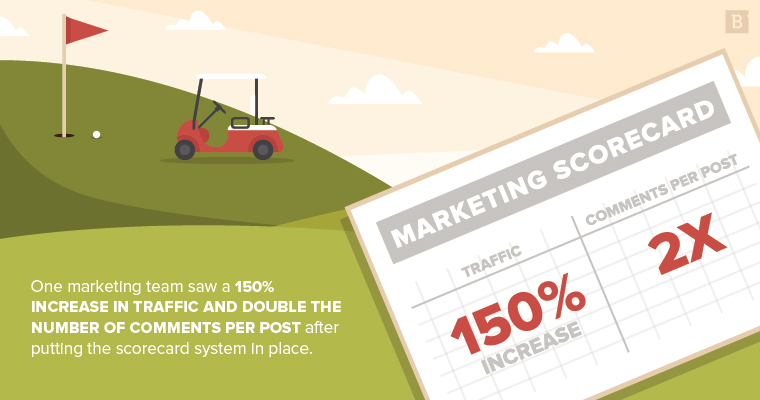Content marketing takes a lot of careful planning and consideration. Not every piece will be a winner with your target audience. But every once in a while, a writer and production team spin a bit of certified gold, and create a piece that engages your audience, supports your marketing goals and furthers your brand’s mission.
And a win like that feels just like this.
But what exactly is it about this piece that attracts and maintains the attention of readers? And what specific elements are the most helpful to the marketing success of your business?
It’s important that such a key piece of content isn’t a one-off, and that your brand is able to repeat this success, time and time again.
Here’s where your marketing scorecard comes in.
Social Media Examiner Garrett Moon explained it’s important for marketers to analyze their latest, greatest pieces of content and use these insights to create a marketing scorecard. This scorecard can then be used to gauge the potential success of future pieces of content, and shape your content marketing work in a way that fosters continuous improvement. The final goal here is balance – you should be able to compare each piece of content to your scorecard, and check off all the boxes of your marketing KPIs included in the card.
What is a marketing scorecard?
A marketing scorecard helps you and your marketing team outline the specific elements and common denominators among your most successful pieces. This way, you can pave the way for future content to align with these same key performance indicators, thereby helping to ensure that it will resonate with your target audience and further your overall marketing goals.

Why is a marketing scorecard important?
Your scorecard will be unique to your business because it will be based on the specific metrics that have worked for your content in the past. Having a scorecard means you don’t waste resources, time and effort creating content that might miss the mark with your customers, or doesn’t support the metrics that align with your marketing campaign goals.
What’s more, over half of all marketers – 61 percent – have found that leveraging analytics is one of the best ways to boost campaign ROI. A proven strategy like this can have a significant impact: Jeff Goins, who first developed the concept of a marketing scorecard, included goals like increasing traffic, engagement and effectiveness. After putting the scorecard system in place, Goins and his team saw a 150 percent increase in traffic, and double the number of comments per post.
TL;DR: Your competitors are likely using a scorecard or some other type of metric-based system to gauge their content, and the results of using one are hard to argue with.
How do I make my scorecard?
The elements included in your scorecard will be tailored to your brand. The first step here is to analyze your top performing pieces of content, based on data and insights from your Google Analytics account. No two scorecards are the same; goals and marketing KPIs change from company to company.
Take a look at your top 10 posts from the previous 12 months. Do a little digging and take the time to identify the common elements or patterns within these pieces. As you read through your top 10, ask yourself questions like:
- What kind of post is it? A list? A how-to piece? A topical piece based on current news, or something more evergreen?
- What’s the word count? Does your audience appreciate longer pieces, or shorter content that’s easier to digest?
- Does the post include or point to free or downloadable resources (templates, worksheets, checklists and other assets)?
- Does it include or lead to other types of content, like videos or ebooks?
- What specific value does the post provide to readers? It’s important to identify the element that they can’t get elsewhere, like a hot take on a certain study, thought leadership around a specific topic area or comprehensive event coverage.
Analyzing these factors is considerably telling. For instance, you may notice that how-to posts featuring videos work especially well for your business, or that longer pieces garner more page views and more time on the page.
But don’t stop there.
Next, take these metrics or marketing KPIs and build them into your scorecard. Let’s take a look at some example criteria:
- A relevant and engaging topic that aligns with your company’s offerings and your core audience’s interests.
- Keyword optimization, including the keywords and long-tail phrases that your brand wants to rank for, as well as those that already have substantial traffic. You should also consider organic ranking difficulty and make sure you goals are attainable.
- The inclusion of statistics and data points backed by trusted sources.
- Comprehensive coverage that tells the whole story and provides value to readers. Examining and touching upon all areas of the topic is important – readers will notice when content seems one-sided or “spun.”
- Actionable insights and a CTA that guides readers to the next best step. It’s important to leverage your blogs to lead prospects through the sales funnel, and one of the best ways to do this is by offering additional, and more in-depth assets on a particular topic. This allows readers to go further and explore more on their own.
- The inclusion of graphical elements, like custom-designed graphics, gifs or an infographic.
It’s important to remember, though, that every business’ scorecard will be different. The elements that resonate and work well for one brand’s target audience may not land as well for another company’s audience.
In addition, keep in mind that your scorecard may be shorter and not include as many factors at first, particularly if you’re just starting out with a scorecard initiative. On the other hand, brands with more well-defined marketing strategies and mature campaigns can create a more comprehensive scorecard.
Once completed, you can use your scorecard to measure the effectiveness of the content you’re creating. Your ultimate goal here is to check off all the boxes included in your scorecard, resulting in a successful and balanced piece of content that’s interesting, encourages engagement and supports your brand. If a piece doesn’t hit all the marks, you and your team will have a good idea of where improvements are needed, and what will take a piece from just okay, to great.





